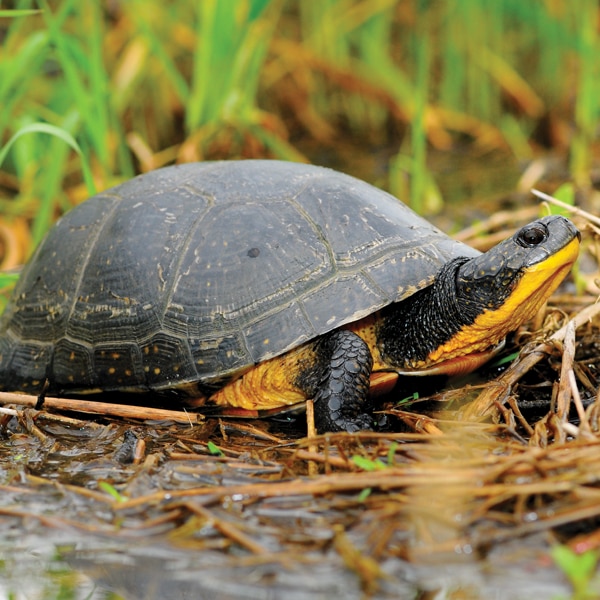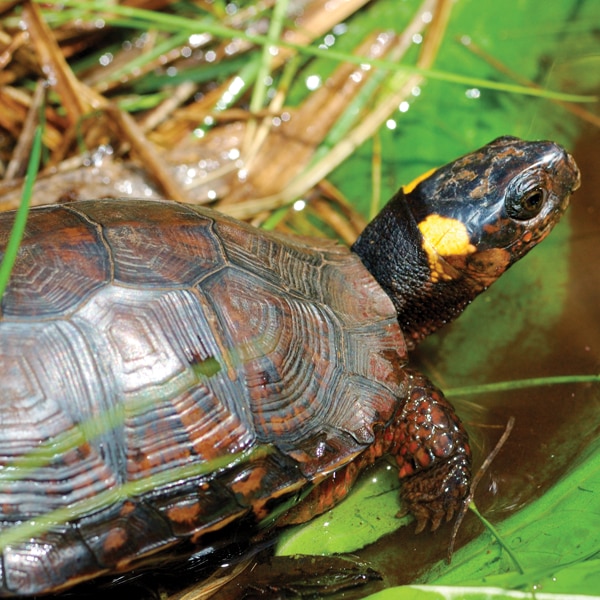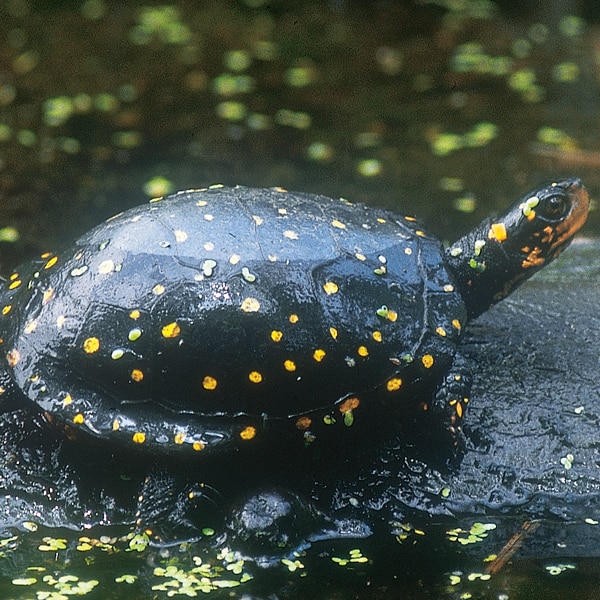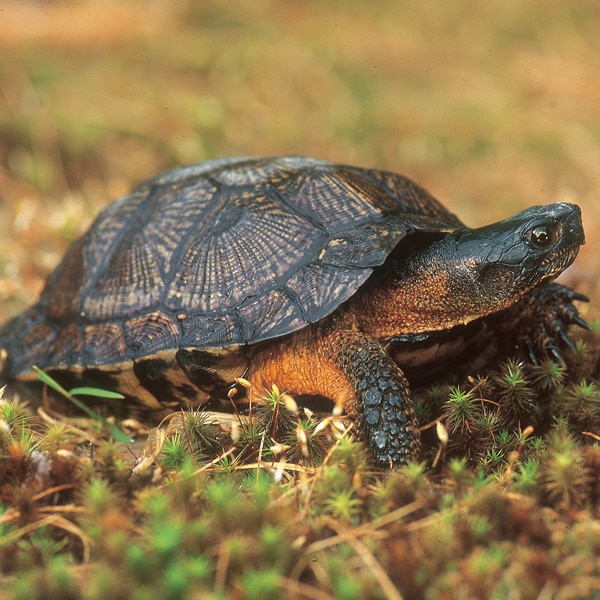- Division of Fisheries and Wildlife
- MassWildlife's Natural Heritage & Endangered Species Program
Media Contact
Media Contact, MassWildlife
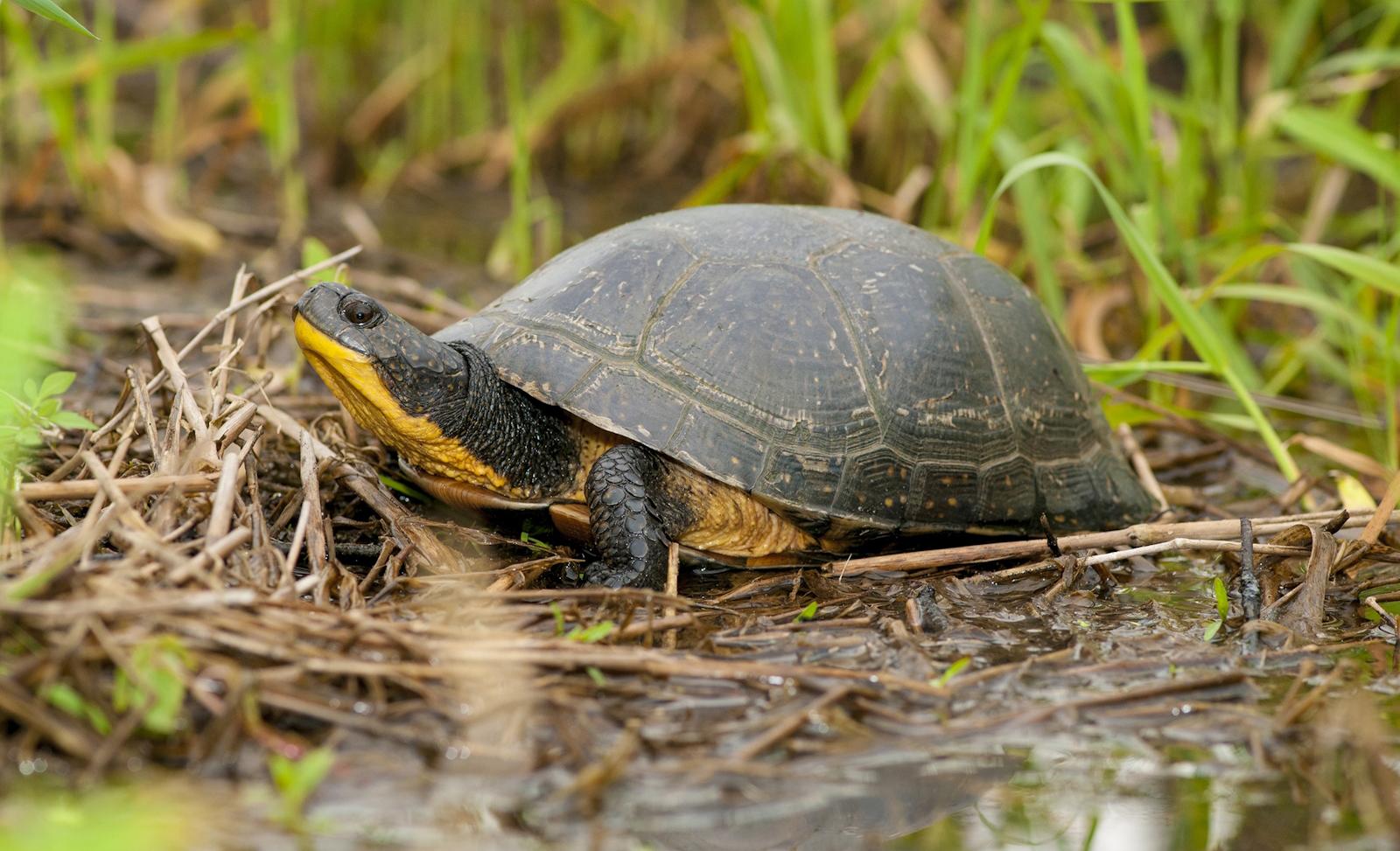
MassWildlife was recently awarded a Competitive State Wildlife Grant from the U.S. Fish and Wildlife Service to support critical conservation efforts to help rare turtles in Massachusetts. Funding from the grant will be used to benefit four different species—Blanding’s, bog, spotted, and wood turtles—through research and habitat improvements. This award will support the implementation of regional conservation plans for each species developed cooperatively by northeastern state wildlife agencies from Maine to Virginia.
MassWildlife will work with municipalities, Massachusetts Department of Conservation and Recreation (DCR), Zoo New England, U.S. Fish and Wildlife Service, and other partners to complete turtle conservation work. A portion of the activities will focus on studying animal movements within prioritized habitat areas and improving data collection and mapping. Other actions such as habitat assessment, nest site restoration, and vernal pool protection will improve vital habitat for turtles and many other types of animals including amphibians and freshwater mussels.
“We look forward to working with our partners and expanding our ongoing conservation efforts for rare turtles,” says MassWildlife’s State Herpetologist, Mike Jones. “This award will allow us to build capacity and make progress towards our goals to stabilize and safeguard imperiled turtle populations and protect important habitats."
Why are turtles in decline?
Turtles live a long time—many freshwater species have lifespans exceeding 40 years. Turtle eggs and hatchlings face a host of predators and very few reach adulthood. Females of many turtle species do not reach sexual maturity (egg laying age) until they are 10–20 years old. Consequently, turtles must live for many years and reproduce many times over decades to replace themselves. If steady, even the occasional loss of an adult turtle, particularly adult females, can result in the local extinction of a population. Adult turtles face many threats that result from human activities, including habitat loss, habitat fragmentation, water pollution, road mortality, illegal collection, disease, and increased predation in urban and suburban areas.
Meet the turtles
Ten species of native freshwater turtles live in Massachusetts. Take a closer look at the four turtles that will benefit from MassWildlife’s latest grant.
Blanding’s turtle (Emydoidea blandingii)
Blanding’s turtles grow to around 6–9 inches and have a dark, high-domed carapace (top shell) that is covered with faint, pale yellow flecking. The deep yellow coloring on their long throat and chin makes these turtles easy to identify. Blanding’s turtles have a relatively large home range and make use of a variety of habitats including marshes, scrub-shrub wetlands, and vernal pools throughout the year. Their omnivorous diet consists of insects, crayfish, worms, tadpoles, and small frogs, as well as aquatic vegetation and carrion.
Females require well-drained loamy or sandy soils for nesting and are known to travel great distances to find a suitable nesting site. Up to a dozen eggs are buried in June; hatchlings emerge between late August and October. The sex of the turtle hatchlings is determined by the temperature of the eggs during incubation. Eggs incubated below a certain temperature (somewhere between 80–86°F) produce males; eggs incubated at higher temperatures produce females.
Status: Listedas Threatened under theMassachusetts Endangered Species Act
Threats: Blanding’s turtles travel to different habitats throughout their lives, making them especially vulnerable to road mortality. Habitat loss and habitat fragmentation are also problems.
Bog turtle (Glyptemys muhlenbergii)
Among the smallest turtle species in the world, adult bog turtles only reach about 4 inches in length. They have a mahogany or dull brown carapace, and many have faint starburst pattern on each section of shell (scute). A distinctive orange patch appears on each side of the head and neck. Bog turtles are opportunistic and will feed on land and in the water. They eat slugs, beetles, millipedes, earthworms, and aquatic vegetation.
The Bog turtle is a habitat specialist that lives in open, shallow, calcareous, flowing wetlands known as “fens”. This habitat type is rare and can be easily degraded by wetland draining or filling, development, or encroachment by trees or invasive plants. Bog turtles overwinter in underground areas with continual flowing water. They may overwinter alone or in groups of other bog turtles or even with other species like spotted turtles. Bog turtles can live for 60 years or more.
Status: Listed asEndangered under the Massachusetts and U.S. Endangered Species Acts
Threats: Habitat loss is the leading threat to bog turtles. This species does not travel far in any given year, so it’s not easy for them to disperse to other suitable locations.
Spotted turtles (Clemmys guttata)
Spotted turtles have a smooth black carapace with a few or many dozen small yellow spots. Dots are also present on the head, neck, and legs. These turtles can be found in forested and non-forested wetlands, marshy meadows, bogs, small ponds and brooks, ditches, other shallow, unpolluted waterbodies. Adults grow to about 3–5 inches in length.
Spotted turtles are relatively cold-tolerant and emerge in early spring around the same time that wood frogs and mole salamander species enter vernal pools to breed. Taking advantage of this food source, spotted turtles feed heavily on the eggs and larvae of amphibians. They also eat aquatic vegetation, snails, and insects. Often seen basking alone or in groups, spotted turtles will quickly dive into the water and bury themselves in the mud if startled.
Status: Not listed in Massachusetts; however, the species is considered a Species of Greatest Conservation Need in the region and is currently under consideration by the U.S. Fish and Wildlife Service for listing under the federal Endangered Species Act.
Threats: Habitat loss and habitat fragmentation are threats to spotted turtles. Illegal collection for the pet trade is also impacting populations.
Wood turtle (Glyptemys insculpta)
Wood turtles are medium-sized turtles (6–8 inches) with a distinctive, warm-brown shell that resembles carved wood. Their head is black and may have faint yellow spots; their legs, neck, and chin are often orange or reddish. Wood turtles live near streams or smaller rivers with dense vegetation along their banks. They also spend time in deciduous forests, fields, and wetland areas. Nesting takes place in June; females lay an average of 7 eggs, which emerge in August. Wood turtles hibernate alone or in groups in streambanks and the root masses of large trees. The lifespan of a wood turtle is easily 60 years.
Status: Listedas a Species of Special Concern under the Massachusetts Endangered Species Act
Threats: Mowing of hayfields and pastures, development of streambanks, roadway casualties, illegal collection for pets, and stream pollution all negatively impact populations.
